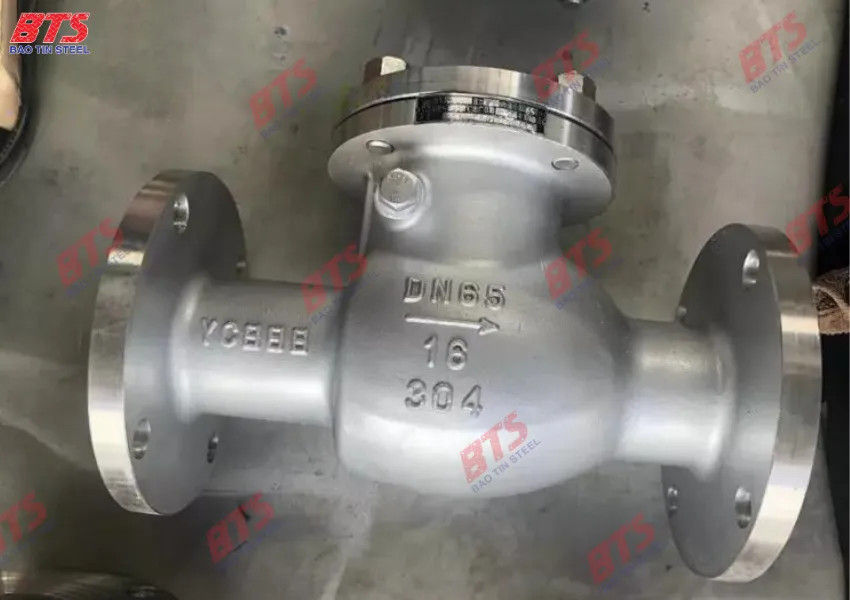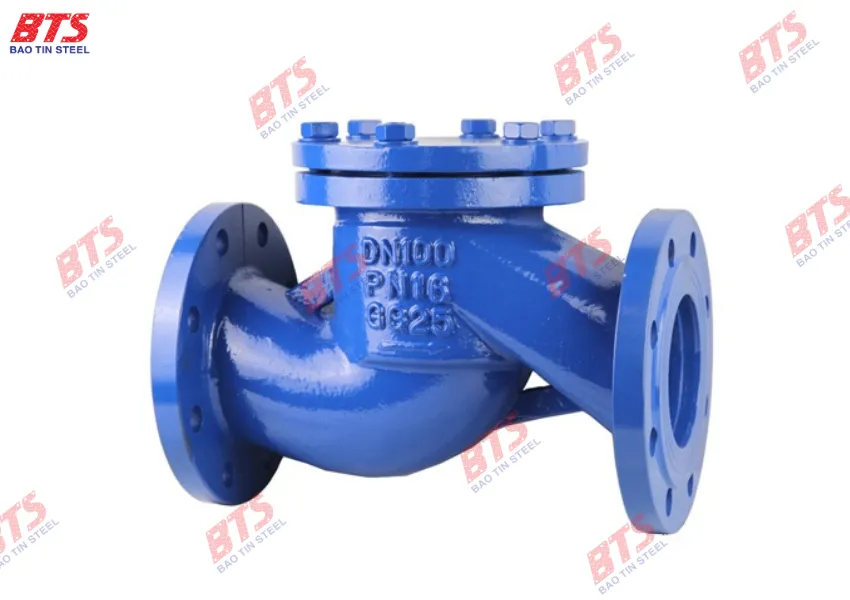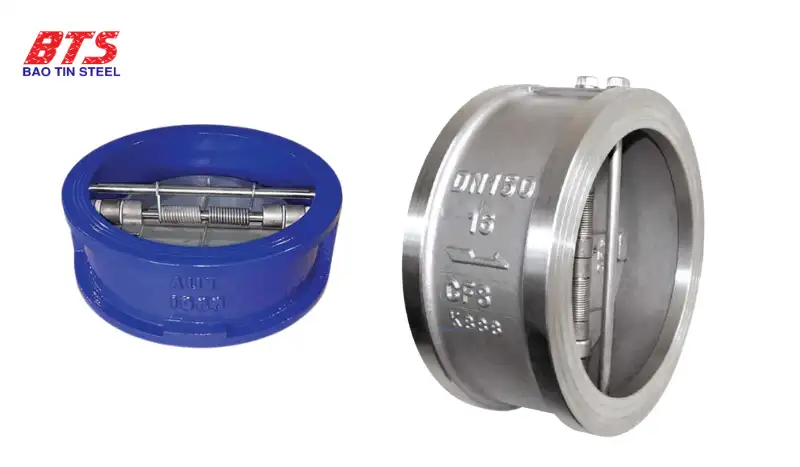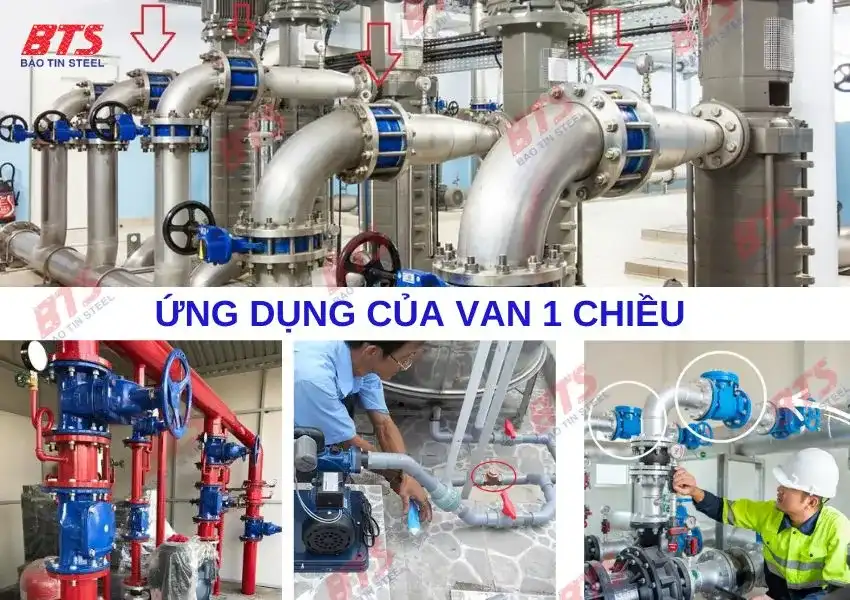A Check Valve is an important device that helps protect pipeline systems from reverse flow, sudden pressure drops, and many other dangerous issues. In this article, Baotin Steel will help you understand what a check valve is, the different types available, their applications, and where to buy them to ensure quality, good prices, and authenticity.
What is a Check Valve?
A Check Valve (also known as a non-return valve) is a type of valve that allows liquid (in either liquid or gas form) to flow through it in only one direction, completely preventing reverse flow.
Each check valve is designed with two ports: one port for the liquid to enter and one port for the liquid to exit.
Features, Principles, and Role of Check Valves
The key feature of a Check Valve is its ability to operate completely automatically, without the need for mechanical or electrical control.
Its working principle is based on pressure differential: when the input pressure is sufficiently high, the valve opens to allow flow; when the pressure drops or flow reverses, the valve automatically closes.
The simplicity in design makes this valve highly reliable, low maintenance, and suitable for a variety of systems—from household water pumps and fire protection systems (PCCC) to industrial processes with special media like steam, corrosive chemicals, or compressed air.
In addition, a Check Valve helps:
- Protect equipment from pressure shocks or hydraulic surges (water hammer).
- Maintain pressure stability within the system.
- Minimise fluid/gas loss in case of leakage.
- Enhance system performance and extend the overall lifespan.
With its essential role and diverse applications, the Check Valve is not only a supporting component but also a strategic part in optimising performance and ensuring safety in modern pipeline systems.
Common Types of Check Valves
Check valves are designed in various shapes, sizes, and materials to meet different technical requirements in practice. Each type of valve has its own construction and working principle, suitable for specific types of fluids, installation directions, and usage environments. Below are the most common types of check valves available today:
Swing Check Valve
Construction: The valve disc swings around a hinge, typically made of cast iron, stainless steel, or brass.
Working Principle: When there is forward flow, pressure pushes the disc open; when the flow reverses or stops, gravity causes the disc to automatically close.
Advantages: Simple design, easy to maintain, and low pressure loss during operation.
Disadvantages: Prone to build-up of debris, which can cause the valve to jam if the fluid contains impurities; may cause water hammer if it closes too quickly.
Applications: Water supply and drainage systems, household pumps, booster pumps, water treatment plants.

Spring/Lift Check Valve
Construction: The valve disc is combined with a spring, and opens and closes in a vertical direction.
Working Principle: The flow pressure overcomes the spring’s force to open the valve; when the flow decreases or reverses, the spring forces the valve disc to close.
Advantages: Fast opening and closing, reduces the effect of water hammer, high sealing performance, and flexible installation in any orientation.
Disadvantages: Requires a sufficiently high initial pressure to open, and may experience pressure drop at low flow rates.
Applications: Steam systems, air compressors, water heaters, high-pressure pipelines.

Butterfly Check Valve
Construction: The valve has two butterfly-shaped discs, mounted on a central shaft, sometimes integrated with a spring.
Working Principle: When there is flow, the two discs open; when the flow stops, gravity or the spring forces the valve discs to close.
Advantages: Compact design, space-saving, and easy to install between flanges.
Disadvantages: Less effective at reducing water hammer, suitable for low-pressure environments.
Applications: HVAC systems, cooling, air conditioning, and domestic water supply.

Ball Check Valve
Construction: A spherical ball is used to open and close the valve, and may be integrated with a supporting spring.
Working Principle: The flow pressure pushes the ball away from its seat, allowing the fluid to pass through. When the pressure drops, the ball falls back to seal the outlet.
Advantages: Self-cleaning, less prone to clogging, stable operation in environments with solid particles.
Disadvantages: Slow closing, may cause water hammer, and can produce noise if the flow is unstable.
Applications: Wastewater systems, sludge treatment, chemical pumps, hydraulic equipment.
Disc Check Valve
Construction: A round disc is held by a spring inside a compact valve body.
Working Principle: When the flow is strong enough, it overcomes the spring force and pushes the disc open; when the flow stops, the spring pushes the disc closed tightly.
Advantages: Good sealing, resistant to high temperature and pressure, suitable for corrosive media.
Disadvantages: Mainly installed in vertical orientation, commonly used in small sizes.
Applications: Hot water systems, steam, boilers, chemicals.
Basic Technical Specifications of Check Valves
When selecting and using check valves, you need to pay attention to the following technical specifications to ensure the valve operates stably, safely, and suits actual operating conditions.
Nominal Size (DN)
- Unit: mm or inch (e.g., DN15, DN50, DN100…)
- Common size range: DN15 – DN1200
Choose the appropriate size according to the flow rate and pipe diameter to ensure the valve opens fully and minimises pressure loss.
Working Pressure
- Unit: PN (Bar) or PSI
- Common ratings: PN10, PN16, PN25, PN40 or 150 PSI – 300 PSI
Must be compatible with the actual system pressure. For steam, hot oil, or hydraulic systems, high-pressure valves should be selected.
Working Temperature
- Ranges from -10°C to 120°C for cast iron, copper, and plastic valves.
Stainless steel or steel valves can withstand temperatures up to 200–800°C. - Materials and valve types should be selected appropriately when used in hot water, steam, or corrosive chemical environments.
Materials of Construction
- Valve Body: Cast iron, stainless steel 304/316, steel, brass, plastic (PVC, uPVC, PP)
- Valve Disc/Ball: Stainless steel, rubber-coated steel, brass, engineering plastics
- Spring (if any): Stainless steel
- Sealing Gasket: EPDM, PTFE, NBR, or synthetic rubber
Connection Types
- Threaded: Used for small-sized valves, quick installation
- Flanged: Strong and suitable for large valves and high pressure
- Clamp/Wafer: Used for thin valves, easy to install in tight spaces
- Union or Glue Joint: For plastic valves or small household valves
Cracking Pressure
- This is the minimum inlet pressure required for the valve to start opening.
- It is important in low-pressure systems, such as water heaters, gravity-fed systems, or small pumps.
- Spring check valves usually have a higher cracking pressure compared to swing check valves.
Sealing Capability
The sealing level of the valve when closed is classified as:
- Gas-tight
- Bubble-tight
- Drop-tight
Selection depends on the system’s strict leak control requirements.
Practical Applications of Check Valves
With their function of preventing reverse flow and fully automatic operation, check valves are widely used in both industrial and residential settings. Below are the most common application areas:
- Water Supply and Wastewater Treatment Systems: Commonly used valves include swing check valves, ball check valves, and butterfly check valves made of cast iron or stainless steel.
- Fire Protection Systems (PCCC)
- HVAC Systems (Heating – Ventilation – Air Conditioning): Preferred valves are spring check valves and stainless steel disc check valves, which are compact and provide good sealing.
- Oil, Gas, and Chemical Pipelines: Stainless steel 316 or alloy steel valves are prioritised for their corrosion resistance and high-pressure tolerance.
- Pumps, Air Compressors, Boilers
- Some Household and Residential Equipment, such as water heaters, RO water filters, washing machines, dishwashers, etc.
- Food, Pharmaceutical, and Bottled Water Industries: Mainly use stainless steel sanitary check valves or plastic diaphragm valves.

Popular and Trusted Check Valve Brands
Currently on the market, there are many check valve brands from different countries. Among them, some prominent names have proven their quality, durability, and reputation through thousands of real projects. Below are the brands trusted by engineers, contractors, and users:
Wonil (South Korea)
Wonil valves are popular in Vietnam due to their stable quality and diverse designs.
They manufacture cast iron, stainless steel, steel, and brass valves in sizes ranging from DN15 to DN300+.
Advantages: Good heat and pressure resistance, reasonable prices, and easy-to-replace parts.
Suitable for: Fire protection projects, HVAC systems, and industrial clean water.
ARV (Malaysia)
ARV is a well-known brand in the industrial and fire protection valve sector.
ARV check valves come in various types: swing, spring, and butterfly.
Durable design, stable operation, and certified with ISO, WRAS, and BS.
Suitable for: Building projects, large pump systems.
ShinYi (Taiwan)
One of the widely trusted brands in Southeast Asia.
ShinYi valves have good quality, solid design, and long-term stable operation.
Competitive pricing relative to quality.
Suitable for: Water treatment systems, water supply and drainage, residential pump systems.
Kitz (Japan)
A premium brand from Japan, renowned for durability, tight sealing, and high precision.
Kitz check valves have exquisite design and excellent corrosion resistance.
Higher price compared to average, suitable for strict technical requirements.
Suitable for: Food processing, pharmaceuticals, and high-grade chemical industries.
Miha (Vietnam)
MIHA is a domestic brand specialising in small-sized brass swing and spring valves.
Threaded connection, easy installation, affordable prices.
Suitable for: Residential water supply systems, household pumps, and water heaters.
Latest Check Valve Price List (For Reference)
The price of check valves depends on various factors such as type, size, material, brand, and connection standards (threaded, flanged, etc.). Prices can vary significantly between residential and industrial valves, or between local and officially imported products.
Below is a reference price list for some commonly used check valve types currently available on the market:
Price List – Cast Iron Swing Check Valves (Flanged Type)
| Size (DN) | Brand | Origin | Reference Price (VND) |
|---|---|---|---|
| DN50 | ARV | Malaysia | 450,000 – 550,000 |
| DN100 | Wonil | South Korea | 950,000 – 1,200,000 |
| DN150 | ShinYi | Taiwan | 1,700,000 – 2,100,000 |
| DN200 | Zetkama | Poland | 3,000,000 – 3,500,000 |
Price List – Stainless Steel Spring Check Valves (Threaded or Wafer Type)
| Size (DN) | Connection Type | Material | Reference Price (VND) |
|---|---|---|---|
| DN15 | Threaded | Stainless Steel 304 | 150,000 – 200,000 |
| DN25 | Threaded | Stainless Steel 304 | 220,000 – 290,000 |
| DN50 | Wafer | Stainless Steel 304 | 450,000 – 650,000 |
| DN80 | Wafer | Stainless Steel 316 | 800,000 – 1,100,000 |
Price List – Plastic Check Valves (PVC, UPVC, PP)
| Size (DN) | Connection Type | Reference Price (VND) |
|---|---|---|
| DN21 – DN42 | Union or Glue Joint | 45,000 – 120,000 |
| DN60 – DN90 | Double Union | 130,000 – 250,000 |
| DN100 | Flanged | 300,000 – 450,000 |
Price List – Brass Check Valves (Residential Use)
| Valve Type | Size (mm) | Reference Price (VND) |
|---|---|---|
| Swing Type | φ21 – φ34 | 60,000 – 120,000 |
| Spring Type | φ21 – φ60 | 90,000 – 220,000 |
| Miha CV50 | DN50 | ~170,000 – 190,000 |
Some Notes When Referencing Prices:
- Prices may vary depending on the brand, order quantity, and fluctuations in input material costs.
- The listed unit prices do not include VAT, shipping, or installation fees.
- It is recommended to request a detailed quotation with CO-CQ (Certificate of Origin and Quality) and a clear warranty policy from the supplier.
- When selecting valves for high-pressure systems or special media, prioritise high-quality valves to ensure safety and long service life.
Buy Genuine Check Valves at Bao Tin Steel
If you’re looking for a trusted place to buy genuine check valves at competitive prices with large in-stock quantities, Bao Tin Steel is a reliable choice.
Why Choose Bao tin Steel?
- 100% Genuine Products: Directly imported from reputable brands, including Wonil (South Korea), ARV (Malaysia), ShinYi (Taiwan), and Kitz (Japan), with full CO-CQ certification.
- Extensive Inventory: A wide variety of check valves available – from swing, spring, and ball types to specialised models made of stainless steel, cast iron, plastic, and brass.
- Competitive Pricing: Attractive discount policies for dealers, contractors, and bulk orders.
- Dedicated Technical Support: A team of knowledgeable specialists ready to assist you in choosing the most suitable valve for your technical needs and working environment.
- Value-Added Services: Pipe cutting, thread machining, and nationwide fast delivery available.

Contact Bao Tin Steel for a Quick Quote: via hotline:


 Tiếng Việt
Tiếng Việt ភាសាខ្មែរ
ភាសាខ្មែរ